

Included on this site are the following areas of the villa: page 1: the Pecile and the Heliocaminus Bath page 2: areas of or near the Imperial Palace, including the Building with Doric Pillars page 3: Maritime Theater page 4: Philosophers' Chamber and Greek and Roman Libraries page 5: Piazza d'Oro page 6: Building with Fishpond and Large Baths page 7: Praetorium, Small Baths and Vestibule, Nymphaeum with three Exedra page 8: the Canopus page 9: the Serapeum and the Temple of Venus | ||
Maritime Theater | ||
| This unique building consists of a circular Ionic portico, probably once barrel-vaulted, then a moat that surrounds a small circular island. Marine friezes were discovered here, thus the modern name of this structure. This was a sort of villa within the villa and provided a retreat from daily life. | 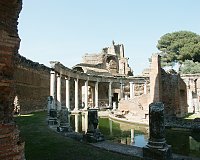
|
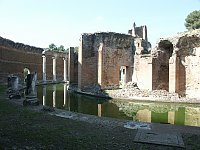
|
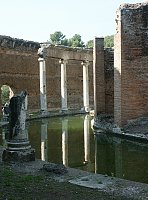
|

|
From the external portico, one could go to the Courtyard of the Greek library or, on the opposite side, to the Philosophers' Chamber. |
| The photograph to the right shows the cement bridge (one of two) crossing the moat; however, in Hadrian's time wooden ramps, which could be removed, were used; thus the island retreat appeared inaccessible. | 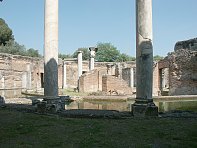
|
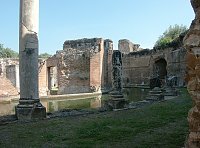
|
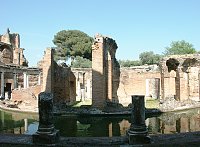
|
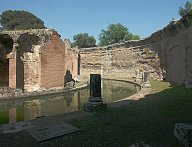
|
Several rooms have been identified on the island--bedrooms, a small bath complex, and a latrine. |
| Several researchers have also suggested that this unique structure had cosmological significance with the central island representing earth, surrounded by water--an image for the primordial ocean. With the concentric circles the building becomes an image of the cosmos--the imago mundi. See especially Henri Stieren, noted below. | ||

|
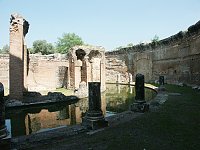
|

|
 Click here to return to index of art historical sites.
Click here to return to index of art historical sites.
 Click here to return to index of artists and architects.
Click here to return to index of artists and architects.
 Click here to return to chronological index.
Click here to return to chronological index.
 Click here to see the home page of Bluffton University.
Click here to see the home page of Bluffton University.
